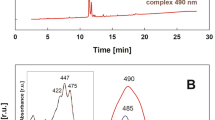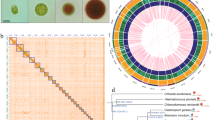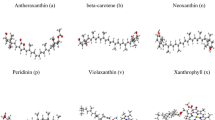Abstract
IN some of the Chlorococcales the biosynthesis of secondary carotenoids (astaxanthin-esters and canthaxanthin1) and the complete decomposition of the primary pigments (chlorophyll a and b, carotenes and xanthophylls) in conditions of nitrogen deficiency can be inhibited by chloramphenicol2. With 5 × 10−5 molar chloramphenicol, growth is reduced to about 85 per cent of the normal rate. Chloramphenicol has no influence on the biosynthesis of the nitrate reducing enzymes in these algae3, and this insensitivity seems to be partly caused by the ability of these organisms to decompose chloramphenicol4.
This is a preview of subscription content, access via your institution
Access options
Subscribe to this journal
Receive 51 print issues and online access
$199.00 per year
only $3.90 per issue
Buy this article
- Purchase on SpringerLink
- Instant access to full article PDF
Prices may be subject to local taxes which are calculated during checkout
Similar content being viewed by others
References
Czygan, F.-C., Experientia, 20, 573 (1964).
Czygan, F.-C., Arch. Mikrobiol., 47, 251 (1964).
Czygan, F.-C., Naturwissenschaften, 51, 244 (1964).
Czygan, F.-C., Naturwissenschaften, 51, 541 (1964).
Kessler, E., Langner, W., Ludewig, I., and Wiechmann, H., Studies on Microalgae and Photosynthetic Bacteria, 7 (1963).
Soeder, C. J., Studies on Microalgae and Photosynthetic Bacteria, 21 (1963).
Kessler, E., and Czygan, F.-C., Arch. Mikrobiol. (in the press).
Author information
Authors and Affiliations
Rights and permissions
About this article
Cite this article
CZYGAN, FC. Effect of Chloramphenicol on Mutants of Chlorella pyrenoidosa. Nature 212, 960 (1966). https://doi.org/10.1038/212960a0
Issue date:
DOI: https://doi.org/10.1038/212960a0
This article is cited by
-
The ultrastructure of the outer cell wall-layer ofChlorella mutants with and without sporopollenin
Plant Systematics and Evolution (1981)
-
Physiologische und biochemische Beitr�ge zur Taxonomie der Gattung Chlorella
Archiv f�r Mikrobiologie (1966)



